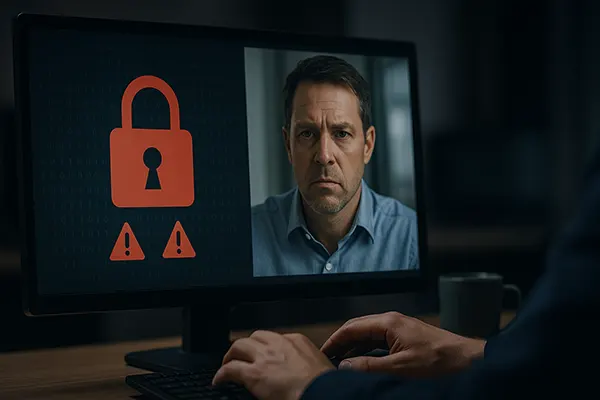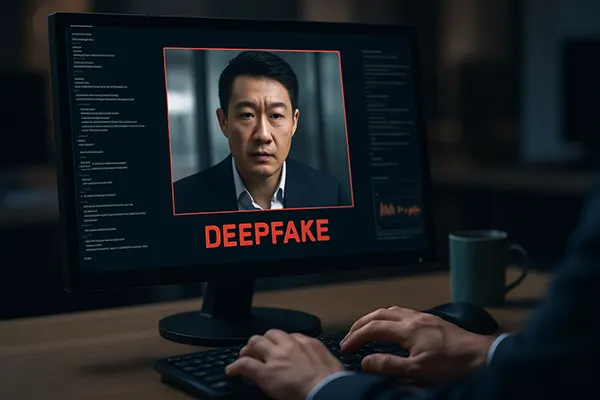Deepfakes are no longer just a novelty on social media — in 2025, they pose a serious and escalating threat to global cybersecurity. Artificial intelligence-generated media is being weaponised in increasingly sophisticated ways, creating new challenges for individuals, companies, and governments alike. From impersonated CEOs to realistic video scams, deepfakes are changing the rules of digital trust.
New Forms of Fraud Enabled by Deepfakes
Over the past year, deepfake technology has advanced to the point where even seasoned cybersecurity professionals struggle to detect manipulated content. Cybercriminals are using these tools to produce hyper-realistic videos, audio clips, and images that convincingly impersonate real people. The result is a dramatic rise in business email compromise (BEC) and financial fraud, especially in sectors like finance, tech, and healthcare.
One notable case in January 2025 involved a UK-based company that transferred over £20 million to scammers following a video call with what appeared to be their CFO. The individual was, in fact, a deepfake clone created using publicly available footage and synthetic voice software. Incidents like this highlight the urgent need for better authentication protocols beyond traditional biometrics or voice recognition.
Financial institutions and enterprises are increasingly adopting real-time detection systems that analyse micro-expressions and inconsistencies in speech patterns to flag potential deepfakes. These solutions, however, remain expensive and not yet widely accessible to smaller businesses or the general public.
AI-Powered Phishing Attacks
Beyond impersonating executives, deepfakes have become a core component of AI-driven phishing campaigns. Cybercriminals now create personalised audio or video messages from a “known” colleague or family member, significantly increasing the success rate of the scam. This highly targeted approach is being dubbed “vishing 2.0” — a blend of voice, video, and synthetic media used in social engineering attacks.
Unlike traditional phishing, where grammar errors or generic messages often raise suspicion, deepfake-enabled attacks are tailored, contextual, and appear convincingly authentic. Employees may receive what looks like a regular Teams or Zoom message from their manager, requesting urgent fund transfers or confidential files.
Cybersecurity experts recommend enhanced training across all corporate levels and the integration of AI-aided filtering tools. However, most solutions are reactive rather than preventative, underscoring the need for a deeper shift in digital literacy and verification protocols.
Recognising Deepfake Content in a Saturated Digital Space
With social media platforms flooded by user-generated content, distinguishing between real and fake is harder than ever. In 2025, deepfakes are not just being used for fraud — they are also a growing tool in political disinformation, blackmail, and harassment. These deceptive assets are often indistinguishable to the human eye, especially when viewed on mobile devices.
Leading tech firms are now implementing watermarking techniques and blockchain-based verification tools to signal authentic media. Adobe, for example, uses its Content Credentials system to tag original footage with metadata that tracks any subsequent edits. Similarly, Meta and TikTok are expanding partnerships with AI watchdogs to scan uploaded videos in real time for signs of manipulation.
Nonetheless, the sophistication of generative models such as GPT-5 and Synthesia Studio makes it nearly impossible to rely solely on software-based detection. Therefore, public awareness campaigns and critical thinking education have become central to the fight against deepfake misinformation. Users must learn to scrutinise content contextually, rather than depending on visual cues alone.
Tools and Techniques for End-Users
While institutions may deploy high-end detection frameworks, individual users are often left vulnerable. Browser extensions like Sensity AI, Amber Video, and Microsoft’s Deepfake Detection Tool are among the few accessible solutions. These tools scan visual and audio content, comparing it against known indicators of synthetically altered media.
Moreover, fact-checking websites and AI-powered verification services now offer quick analysis of suspicious media, particularly around viral news stories and high-stakes political events. These platforms typically analyse facial movements, lighting anomalies, and audio synchronisation errors.
Despite these advances, no consumer tool is foolproof. Cybersecurity experts advise verifying messages through alternative channels, avoiding immediate reactions to emotionally charged content, and reporting suspected deepfakes to relevant authorities.

Protecting Businesses and Users in a Deepfake Era
In response to the increasing threat, businesses are shifting their cybersecurity strategies. In 2025, security audits now include deepfake vulnerability assessments. Organisations are also introducing biometric safeguards combined with behavioural authentication — tracking typing speed, mouse movements, and reaction patterns to verify identity.
Additionally, cybersecurity insurance policies have evolved to cover deepfake-related incidents. Lloyd’s of London, for example, launched new policies this year aimed at helping businesses recover from financial and reputational damage caused by synthetic media attacks.
Training has also become a cornerstone. Major corporations are rolling out deepfake response drills, similar to phishing simulations, to prepare employees for potential scenarios. Regular updates and awareness materials are distributed to reinforce vigilance and help users identify anomalies in real-time communications.
Future-Proofing Cybersecurity Strategies
Looking ahead, the industry anticipates more advanced authentication layers, such as zero-trust frameworks integrated with AI-driven anomaly detection. Zero-trust assumes no internal or external party is automatically trustworthy, requiring continual verification across all access points.
Collaboration will also be critical. Governments, tech companies, and academic institutions are forming global alliances to standardise detection protocols and share threat intelligence. The EU’s AI Act and the UK’s Online Safety Bill are key regulatory milestones pushing for transparency in synthetic content creation and distribution.
Ultimately, deepfake protection is not a one-time implementation — it requires continuous evolution. By investing in education, detection technology, and cross-industry partnerships, we can begin to mitigate the damage and defend against the invisible threat that continues to evolve.



